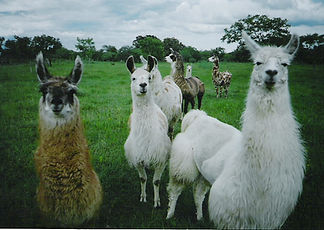
Exotic Animal Barn
Llamas
*Classic Llama (Ccara Sullo)- This is the traditional llama that has a taller and larger body than other types of llamas. With less fiber on its neck, legs, and head, the hair on this llama’s coat is a bit longer than the other parts of the body, making it resemble a saddle. Some even have neck hair that makes it look like a mane. In fact, the term “classic” refers to their coat type. They have double-coated fleece and a fine undercoat, but when you keep the hair combed it is a lot less dense, even sparse.
*medium- has long fibers on the body and neck region, but shorter fibers on the head, legs, and ears than the wooly llama. Even the experts sometimes have a difficult time telling the difference between the medium llama and the wooly llama, even though there are some differences. The medium llama has a fleece that is double-layered, with long, rough guard hairs that extend with a great undercoat. Some of these llamas are the result of breeding a wooly llama and a traditional or common llama.
*Suri- are extremely rare and offer wool protection such as the wooly llama, the difference is that the fibers are much less fine than they are on the wooly llamas.
*Vicuna- if you’re looking for a sweater or overcoat made of some of the softest material on the planet, try an item made with the wool of a Vicuna llama. Of course, because these llamas can only be shorn every three years and it takes up to 30 llamas to make just one coat, this type of wool is very rare – even more rare than cashmere.
*Wooly- smaller than many other types of llamas, the wooly llama has strong wool covering the entire body, particularly on the head, neck, and ears. Their fiber is very kinky and thick, and it is mixed with a minimum number of guard hairs.


.jpg)
.jpg)
Alpacas
*Huacaya- Soft, gentle, and the luxurious feeling of cashmere. That is the Huacaya. The fleece of the Huacaya is used for many fiber processes, mainly it is used as a fine suiting cloth. Other uses include, however, felting, knitwear, weaving and blending with other natural fibers.
*Suri- Elegant, sleek and straight. While unlike the Huacaya, which has gentle crimped strands of hair the Suri is straight, almost like a silk drape- a beautiful touch. The Suri alpaca is mainly used as cloth for the production of luxurious overcoats.
.jpg)
Exotic Animal Terms
Blanket- the part of an alpaca’s coat that extends from the nape of the neck at the withers along to the tail and down the flanks to the belly and haunches. This is usually the softest, "Prime" fleece.
Hembra- female alpaca or animal.
Macho- male alpaca used in a breeding program.
Bred Female- pregnant alpaca.
Character- the overall evaluation of fleece or lock as based on the handle, staple length, fineness, density, luster, and softness.
Cria (Cree-a)- baby alpaca or llama.
Handle- the way an alpaca fiber feels when touched; sometimes used interchangeably with “softness”.
Prime Fleece- the best fleece an alpaca will ever produce, usually its fur coat called Tui.
Shearing- the once-a-year harvesting of alpaca fibers usually carried out in mid-spring in order to make alpaca cooler through the summer and allow the coat time to grow back before the cold returns.
Dust Pile- a bare area on the ground which llamas use for rolling.
Humming- the sounds that llamas make when they are tired, stressed, hot, uncomfortable, curious or concerned.
There are different types of hums for different causes.
Maiden Female- female who has not been bred to a male yet, usually because she is too young.
Open Female- female who is not pregnant.
Stud- male llama who is used to breed females. He can also be called a herdsire.
Woolies- term sometimes used to refer to llamas who have heavy wool coverage.
What's more amazing than a talking llama?
-A spelling bee!

A llama saw itself in the mirror..
-It was the spitting image




What did the llama say when he was packing a picnic?
-Alpaca lunch










